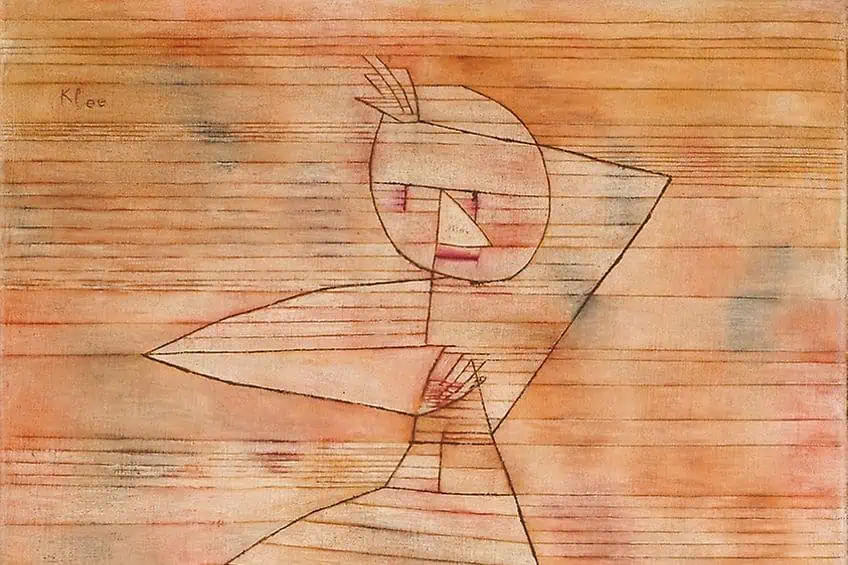Famous Line Artists and Artworks – A Look at the 10 Best
Lines form an integral part of what makes or breaks an artwork. As one of the basic elements in art, line is incredibly powerful in establishing elements that guide the viewer’s eye, place the subject in focus, and provide texture to a drawing or painting. In this article, we will introduce you to the 10 most famous line artists and artworks that showcase the beauty of line in art history, and its role in some of the world’s masterpieces. Keep reading for more about these expert line drawing artists!
Contents
- 1 An Introduction to Line Art
- 2 The Top 10 Famous Line Artists and Artworks
- 2.1 Leonardo da Vinci (1452 – 1519)
- 2.2 Albrecht Dürer (1471 – 1528)
- 2.3 Vincent van Gogh (1853 – 1890)
- 2.4 Henri Matisse (1869 – 1954)
- 2.5 Piet Mondrian (1872 – 1944)
- 2.6 Paul Klee (1879 – 1940)
- 2.7 Pablo Picasso (1881 – 1973)
- 2.8 Jackson Pollock (1912 – 1956)
- 2.9 Bridget Riley (1931 – Present)
- 2.10 Keith Haring (1958 – 1990)
- 3 Frequently Asked Questions
An Introduction to Line Art
What is line art, and why is line such an important element? The art of effectively using lines in art is a form of artistic expression that relies on one of the simplest types of marks, lines, to create designs, illustrations, and images. Line art includes art that is drawn, painted, or sculpted, and depicts illustrated lines in different forms. These include lines such as curved and straight lines, arranged in different ways to achieve a desired visual effect. Line art is often understood as black and white, binary, and reliant on the medium of drawing. In art history, line art has evolved from simple drawings on paper to important techniques in mediums like printmaking that highlight just how important lines are.
 Mime van Osen (1910) by Egon Schiele; Egon Schiele, Public domain, via Wikimedia Commons
Mime van Osen (1910) by Egon Schiele; Egon Schiele, Public domain, via Wikimedia Commons
So, what is the significance of lines in art? Line drawing artists may employ lines in a variety of ways that range from grayscale studies to color compositions across drawing, printmaking, and painting. Line is first and foremost considered to be a fundamental element in art that is significant for several reasons. Line serves as the base for an artwork’s composition and allows artists to define the main structures, shapes, and forms in the composition. Proportion can also be defined using lines and bring a sense of emotion, movement, depth, and flow within a work of art.
Additionally, line art is effective in portraying abstract ideas, emotions, or objects, which are elevated through the simplicity of line itself, thus making it a versatile mark in illustration, fine art, and graphic design. Many of the world’s most famous line artists share a common appreciation for the power and elegance offered by the simplicity of line. For centuries, artists working with lines have mastered the functions of lines by weaving detailed narratives and inspiring complex emotions, even with minimalistic lines.
Below, you will find our compilation of the top 10 artists that use lines to create incredible and striking works of art.
The Top 10 Famous Line Artists and Artworks
To master line in art, one has to consider the skills of control and precision when it comes to managing lines and planning their placement for the most impact. Of the many famous artists that use lines, the best ones tend to experiment with the potential of line and elevate simple line techniques such as stippling and cross-hatching to provoke thought, drive symbolism, and amplify the universal appeal of lines. Below, we will explore the top 10 most famous line artists and artworks that will surely inspire you to learn more about this flexible art element.
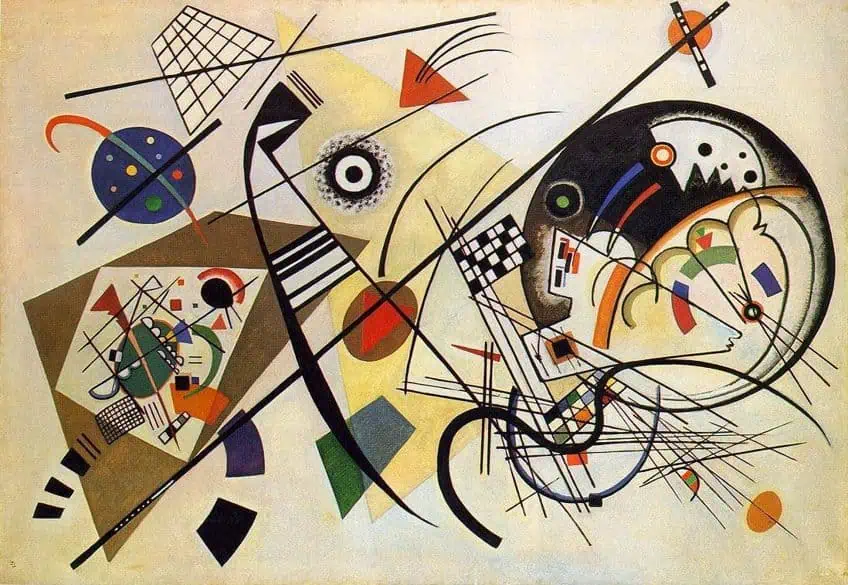 Transverse Line (1923) by Wassily Kandinsky; Василий Кандинский (Wassily Kandinsky), Public domain, via Wikimedia Commons
Transverse Line (1923) by Wassily Kandinsky; Василий Кандинский (Wassily Kandinsky), Public domain, via Wikimedia Commons
Leonardo da Vinci (1452 – 1519)
| Name | Leonardo di ser Piero da Vinci |
| Date of Birth | 15 April 1452 |
| Date of Death | 2 May 1519 |
| Nationality | Italian |
| Associated Movements, Themes, and Styles | Renaissance, High Renaissance, religious art, scientific illustrations, and portraiture |
| Mediums | Drawing and painting |
| Famous Artworks | ● Vitruvian Man (c. 1490) ● A Study of a Woman’s Hands (c. 1490) ● La Scapigliata (c. 1506 – 1508) ● Portrait of a Man in Red Chalk (1512) |
Leonardo da Vinci was the greatest line artist of the Italian High Renaissance, whose delicate handling of lines is almost divine itself. Da Vinci created many famous line drawings and was recognized as a Renaissance master, who thrived across multiple disciplines. Da Vinci’s line work was best captured in his unfinished sketches in red chalk, ink, and graphite that showcase his thorough understanding of the different effects that line can have on a simple two-dimensional artwork.
Da Vinci’s drawings are celebrated for their anatomical accuracy and high detail illustrating Da Vinci’s approach to line and the different techniques in mark-making that he used to create contrast, build depth, form, and outline his subjects.
Vitruvian Man (c. 1490)
| Date | c. 1490 |
| Medium | Ink on paper |
| Dimensions (cm) | 35 x 26 |
| Where It Is Housed | Gallerie dell’Accademia, Venice, Italy |
The Vitruvian Man is just one classical line art example illustrating Da Vinci’s skill in line work, where he used lines to create an outline of human proportions, which he studied diligently at the time. The famous line drawing became an iconic symbol of Renaissance ideals, which witnessed the marriage of science and art through Humanism and its focus on mathematically driven proportions in architecture and art. For Da Vinci, proportion was best displayed through lines, which form the basis of all structures and can be used as a guide to calculate the proportions of the human body, which Da Vinci captured in a square and circle. A few other famous line drawings by Da Vinci include La Scapigliata (c. 1506-1508) and Portrait of a Man in Red Chalk (1512).
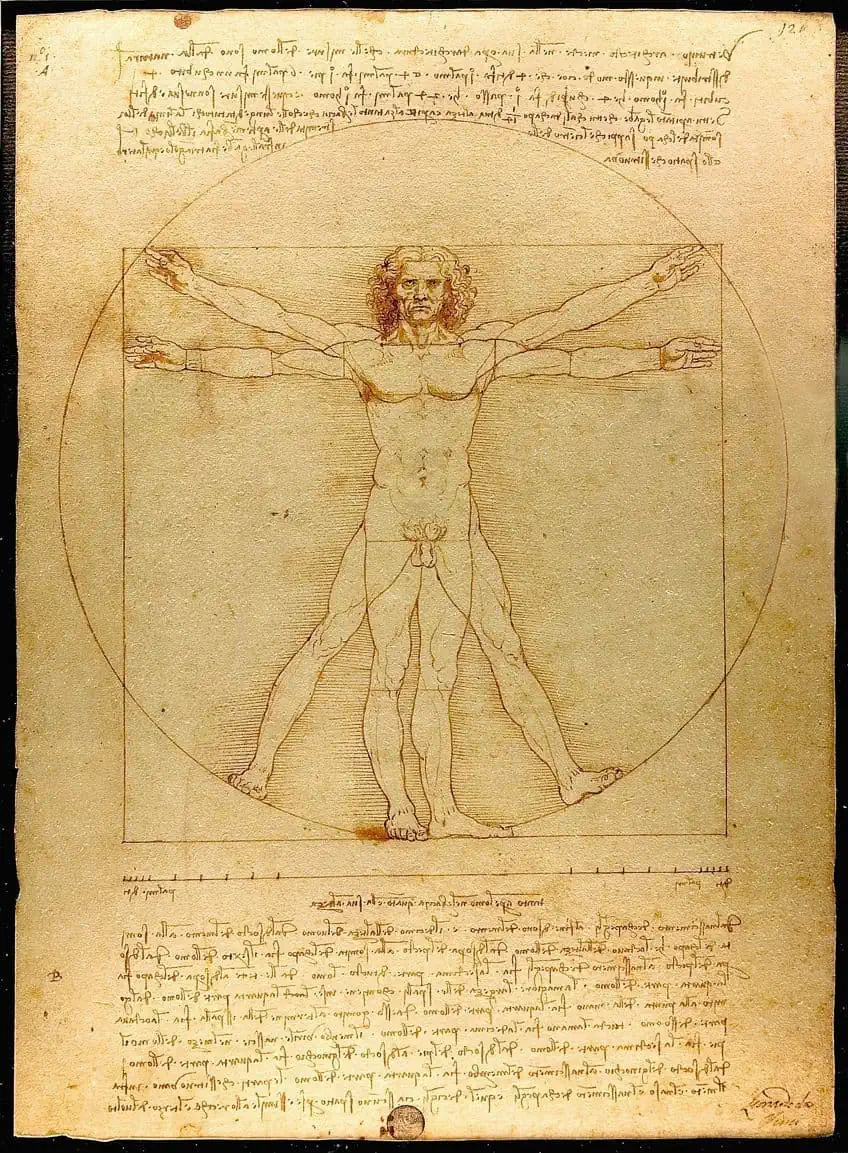 Vitruvian Man (c. 1490) by Leonardo da Vinci; Leonardo da Vinci, Public domain, via Wikimedia Commons
Vitruvian Man (c. 1490) by Leonardo da Vinci; Leonardo da Vinci, Public domain, via Wikimedia Commons
Albrecht Dürer (1471 – 1528)
| Name | Albrecht Dürer |
| Date of Birth | 21 May 1471 |
| Date of Death | 6 April 1528 |
| Nationality | German |
| Associated Movements, Themes, and Styles | German Renaissance, Gothic art, and the Northern Renaissance |
| Mediums | Painting, printmaking, theory, and drawing |
| Famous Artworks | ● Saint Eustace (1499 – 1501) ● Young Hare (1502) ● Madonna of the Pear (1512) ● Knight, Death and the Devil (1513) ● Dürer’s Rhinoceros (1515) |
This famous 16th-century line master was one of the greatest engravers of his time, whose mastery over line has been highly praised for centuries. The German Renaissance artist Albrecht Dürer undoubtedly created some of the most detailed engravings and many famous line drawings using a variety of line marks to create contrast, texture, and tone, and execute his works with the utmost precision. Dürer specialized in religious and mythological iconographies, from which he selected various narratives and scenes to portray in intricate compositions.
An icon of the Northern Renaissance, Dürer was inspired by the prevailing ideas around proportion, mathematics, and perspective of his day, which inspired many great artists of the 16th century.
Madonna of the Pear (1512)
| Date | 1512 |
| Medium | Original engraving printed in black ink on laid paper |
| Dimensions (cm) | 15.7 x 10.8 |
| Where It Is Housed | Christopher-Clark Fine Art, San Francisco, United States |
One of Dürer’s most famous prints was a 1512 engraving titled Madonna of the Pear, which features his monogram subtlety placed in the bottom left of the composition. His refined lines appear all across the work in varying degrees of intensity, from curved lines on the tree bark to the cross-hatching on the Madonna’s garment. Dürer also skillfully rendered extra lines to create contrast in areas that ought to be darker while leaving certain elements blank to illustrate texture and distinguish them from one another. This can be seen in the contrast of the airy clouds to the still and continuous long lines of the atmosphere. Other famous line drawings by Albrecht Dürer include Knight, Death and the Devil (1513) and Dürer’s Rhinoceros (1515).
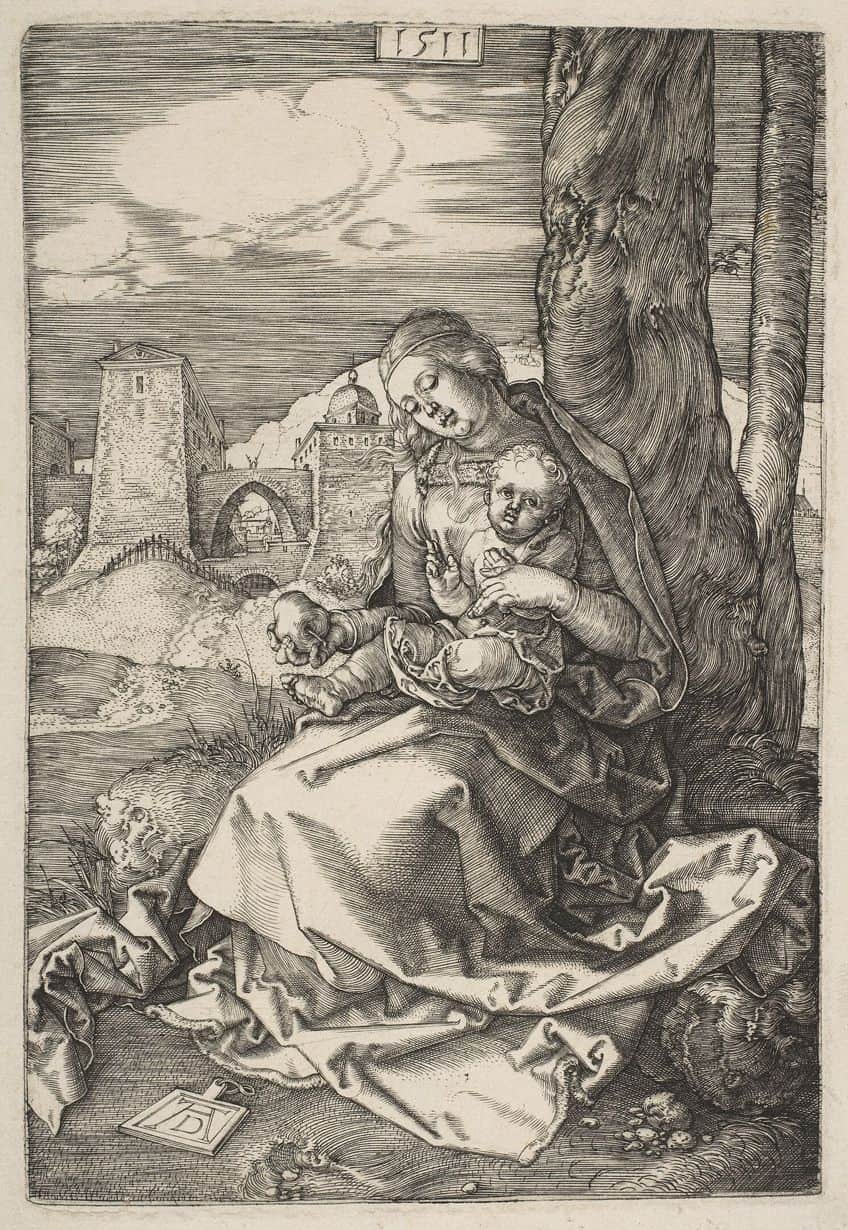 Madonna of the Pear (1512) by Albrecht Dürer; Albrecht Dürer, CC0, via Wikimedia Commons
Madonna of the Pear (1512) by Albrecht Dürer; Albrecht Dürer, CC0, via Wikimedia Commons
Vincent van Gogh (1853 – 1890)
| Name | Vincent Willem van Gogh |
| Date of Birth | 30 March 1853 |
| Date of Death | 29 July 1890 |
| Nationality | Dutch |
| Associated Movements, Themes, and Styles | Post-Impressionism, Modern art, Pointillism, Neo-Impressionism, landscape art, and portraiture |
| Mediums | Painting and drawing |
| Famous Artworks | ● Self-Portrait with a Straw Hat (1887) ● Bedroom in Arles (1888) ● The Night Café (1888) ● The Starry Night (1889) ● Van Gogh Self-Portrait (1889) ● Tree Roots (1890) ● Wheatfield with Crows (1890) |
A fascinating pioneer of post-Impressionism and one of the most famous artists that used lines, Vincent van Gogh, was a celebrated icon in painting, whose use of line in landscape painting and portraiture resulted in some of the most exquisite paintings you will ever find. Van Gogh was a famous Dutch painter, who suffered terribly from bouts of mental distress and many challenges in his life as an artist.
Van Gogh’s life-long journey of immortalizing himself and his travels in his paintings showcase his use of line as not only a device for creating perspective in his landscape and interior works but also to highlight his mental anguish, even in his last days.
Tree Roots (1890)
| Date | 1890 |
| Medium | Oil on canvas |
| Dimensions (cm) | 50 x 100 |
| Where It Is Housed | Van Gogh Museum, Amsterdam, the Netherlands |
Tree Roots is one such painting by Van Gogh that was created around the same period as his death. The painting, like many of those painted in the last few years of his life, showcases his strong affinity to line as his lines became bolder, darker, and more frequent in the years between 1888 and 1890. Van Gogh’s painting style was characterized by his swirling lines to outline the movement of the spaces he depicted and was complemented by the brilliant and rich colors he used to depict scenes in paintings such as The Starry Night (1889) and Wheatfield with Crows (1890). In Tree Roots, one can pick up on the emotional state of Van Gogh through his erratic use of strong dark lines in an abstract arrangement of tree roots and their trunks. Here, his lines appear confident, yet the color is more sparse than in his previous works. His self-portraits also began to demonstrate his increased use of lines to fill up his compositions and use lines to define his image in its entirety, which contrasts with his earlier self-portraits. Van Gogh’s unique use of lines in painting became his signature style, which is incomparable to any other post-Impressionist of his day.
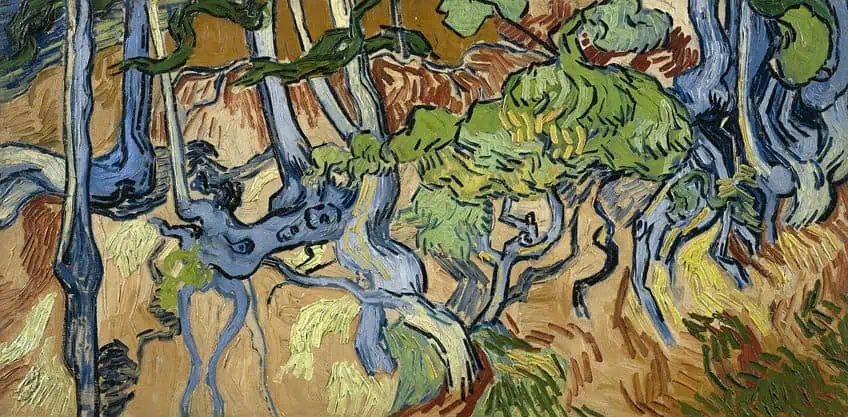 Tree Roots (1890) by Vincent van Gogh; Vincent van Gogh, Public domain, via Wikimedia Commons
Tree Roots (1890) by Vincent van Gogh; Vincent van Gogh, Public domain, via Wikimedia Commons
Henri Matisse (1869 – 1954)
| Name | Henri Émile Benoît Matisse |
| Date of Birth | 31 December 1869 |
| Date of Death | 3 November 1954 |
| Nationality | French |
| Associated Movements, Themes, and Styles | Modern art, Impressionism, Fauvism, Post-Impressionism, and Neo-Impressionism |
| Mediums | Painting, sculpture, drawing, and draftsmanship |
| Famous Artworks | ● Landscape at Collioure (1905) ● View of Notre-Dame (1914) ● Large Reclining Nude (1935) ● Blue Nudes (1952) ● Le Bateau (1953) |
Henri Matisse is among the most famous line artists of the 20th century whose unique approach to emphasizing line in collage and painting made him one of the most innovative artists. Matisse was best known for his Fauvist and Neo-Impressionist compositions that incorporated lines as a way to draw attention to perspective, movement, and form in his works.
A pioneer of Modern art, Matisse’s paintings capture the vibrancy of the landscapes and people he wished to capture as he used lines to define his subjects.
Landscape at Collioure (1905)
| Date | 1905 |
| Medium | Oil on canvas |
| Dimensions (cm) | 39 x 47 |
| Where It Is Housed | The Museum of Modern Art, New York City, United States |
One of Matisse’s most famous line artworks is Landscape at Collioure, which was painted in 1905 and is considered a prime line art example of how Matisse relied on line to convey the dynamism of the scene. This seemingly simple landscape painting is made up of a mixture of different line markings that accentuate the landscape and bring color to its still forms. Through directional line markings, Matisse brilliantly establishes the life of the natural landscape, bringing to life the vegetation and atmosphere of the scene through a colorful combination of short lines.
Piet Mondrian (1872 – 1944)
| Name | Pieter Cornelis Mondriaan (later known as Piet Mondrian) |
| Date of Birth | 7 March 1872 |
| Date of Death | 1 February 1944 |
| Nationality | Dutch |
| Associated Movements, Themes, and Styles | Modern art, Cubism, De Stijl, Expressionism, Impressionism, and Abstract art |
| Mediums | Painting |
| Famous Artworks | ● Composition A (1923) ● Composition with Red Blue and Yellow (1930) ● New York City I (1942) ● Broadway Boogie Woogie (1942 – 1943) |
Another unforgettable painter who leveraged line to bring out the best in abstract compositions was Piet Mondrian, a famous Dutch artist associated with the De Stijl movement. One may immediately recognize his signature grid-like compositions that use elements of strong bold dark lines to outline the grids of his compositions and work in contrast with the primary blocks of color.
Mondrian was widely praised as a talented art theoretician and abstract artist of the early 20th century who prioritized geometric forms in his practice as a form of utopian research into universal aesthetics.
Composition with Red Blue and Yellow (1930)
| Date | 1930 |
| Medium | Oil on canvas |
| Dimensions (cm) | 45 × 45 |
| Where It Is Housed | Kunsthaus Zürich, Zürich, Switzerland |
Composition with Red Blue and Yellow is among Mondrian’s most famous and recognizable line artworks that showcases his dedication to exploring asymmetry and relational opposites in contrast to the pure blocks of color. His use of line separates the primary colors while simultaneously highlighting their harmony in their placement together, as colors that incite tension and dynamism.
 Composition with Red Blue and Yellow (1930) by Piet Mondrian; Piet Mondrian, Public domain, via Wikimedia Commons
Composition with Red Blue and Yellow (1930) by Piet Mondrian; Piet Mondrian, Public domain, via Wikimedia Commons
Paul Klee (1879 – 1940)
| Name | Paul Klee |
| Date of Birth | 18 December 1879 |
| Date of Death | 29 June 1940 |
| Nationality | Swiss-German |
| Associated Movements, Themes, and Styles | Modern art, Bauhaus, Der Blaue Reiter, Expressionism, Surrealism, and Cubism |
| Mediums | Painting, drawing, and printmaking |
| Famous Artworks | ● Death for the Idea (1915) ● Angelus Novus (1920) ● Ghost of a Genius (1922) ● Fleeing Ghost (1929) ● Death and Fire (1940) |
Paul Klee is one of the most famous line artists of Expressionism, whose works fell into the sub-movement known as Der Blaue Reiter. Klee’s career as a painter and printmaker highlighted his skill in line work as his stylized and illustrative figures show his delicate approach to form. In an almost animated manner, Klee approached his works with styles that were inspired by other Modern movements such as Surrealism and Cubism, which impacted not only his compositions but also his child-like handling of mark-making and line. He subtly incorporated lines into his works in a way that brought balance to his compositions and helped establish a contrast between a form and the background of the work.
For his more abstract paintings, Klee’s approach to line was bold and gestural, which captured his personal experience with scleroderma throughout the 1930s.
Fleeing Ghost (1929)
| Date | 1929 |
| Medium | Oil on canvas |
| Dimensions (cm) | 89.5 x 63.5 |
| Where It Is Housed | The Art Institute of Chicago, Illinois, United States |
Fleeing Ghost is a classic line art example of Klee’s playful and delicate handling of lines to create a composition that outlines the form of a ghostly figure while conveying its movement. The figure was rendered in an essentialized and simplified form using bare geometrical shapes and lines to illustrate its body. Klee also included an arrow facing the direction that the figure turns to flee in and uses a series of closely packed horizontal lines in the background to illustrate the figure’s hurried nature.
 Fleeing Ghost (1929) by Paul Klee; Paul Klee, Public domain, via Wikimedia Commons
Fleeing Ghost (1929) by Paul Klee; Paul Klee, Public domain, via Wikimedia Commons
Pablo Picasso (1881 – 1973)
| Name | Pablo Ruiz Picasso |
| Date of Birth | 25 October 1881 |
| Date of Death | 8 April 1973 |
| Nationality | Spanish |
| Associated Movements, Themes, and Styles | Modern art, Cubism, Analytical Cubism, Surrealism, Primitivism, and portraiture |
| Mediums | Painting, sculpture, printmaking, theater design, writing, and ceramics |
| Famous Artworks | ● Large Nude in Red Armchair (1929) ● Two Girls Reading (1934) ● The Weeping Woman (1937) ● Francoise (1946) ● Head of a Woman (c. 1950s) ● Dancer (1954) ● Jacqueline (1961) |
Largely celebrated for his contribution to Cubism and Spanish art, Pablo Picasso was also a respected line artist, whose background in printmaking and understanding of simplified forms established his reputation as a successful line artist. Picasso’s expertise extended to line works that demonstrated flow and harmony and are recognized for the artist’s use of continuous singular lines to outline the subject. In many portraits and illustrations, one can catch a glimpse of Picasso’s mastery of line and form.
His elegant line works were best captured in series such as his 1950s works from War and Peace.
Francoise (1946)
| Date | 1946 |
| Medium | Lithograph |
| Dimensions (cm) | 65 x 50 |
| Where It Is Housed | Bruun Rasmussen Auctioneers, online |
Francoise is an example of Picasso’s continuous line work in portraiture, which he created in 1946 as part of an edition of 50 lithograph prints. This simple line portrait conveys the simplicity through which Picasso approached his subjects and understood their forms. Using a series of confident lines, Picasso created the likeness of the woman, who is believed to be identified in the title as Francoise, with a darker line over the left side of her face to emphasize the invisible light source shining on her.
Jackson Pollock (1912 – 1956)
| Name | Paul Jackson Pollock |
| Date of Birth | 28 January 1912 |
| Date of Death | 11 August 1956 |
| Nationality | American |
| Associated Movements, Themes, and Styles | Modern art, Abstract Expressionism, and action painting |
| Mediums | Painting |
| Famous Artworks | ● Stenographic Figure (1942) ● Mural (1943) ● Blue Poles (1952) ● Convergence (1952) |
Jackson Pollock was one of the Modern era’s most famous and influential Abstract Expressionists, whose drip technique and action painting approach led to some of the most dynamic and popular abstract artworks to date. Pollock was a key figure in abstract art who relied on lines created by the occurrence of “controlled chance”, which he executed through action painting and paint pouring.
His curvilinear and expressive lines are highlighted in his placement of color, which he combines and layers with other colors to create chaotic and striking works.
Blue Poles (1952)
| Date | 1952 |
| Medium | Enamel and aluminum paint with glass on canvas |
| Dimensions (cm) | 210 x 486 |
| Where It Is Housed | National Gallery of Australia, Canberra, Australia |
Blue Poles is one of Pollock’s most famous line paintings that emphasizes the distinct lines of the composition. The painting was initially titled No. 11 and was first exhibited under its new title in 1954 at the Sidney Janis Gallery. His ambiguous title Blue Poles acts as a guide that limits one’s comprehension of the work, as noted by an art historian, who also observed that the title directly draws one’s attention to the main component of the work, the blue lines. Today the painting is valued between $100 and $350 million as it sits as one of the most popular artworks of the National Gallery of Australia.
Bridget Riley (1931 – Present)
| Name | Bridget Louise Riley |
| Date of Birth | 24 April 1931 |
| Nationality | English |
| Associated Movements, Themes, and Styles | Modern art, Op art, and hard-edge painting |
| Mediums | Painting and printmaking |
| Famous Artworks | ● Untitled (Fragment 1) (1965) ● Arrest 1 (1965) ● Breathe (1966) ● Untitled (Diagonal Curve) (1966) ● Untitled (Winged Curve) (1966) ● Achean (1981) |
Bridget Riley is one of the most famous Contemporary line artists whose legacy is cemented in the op-art movement of the 1960s. Riley is considered to be an icon in line art and is best known for her mastery of monochrome black-and-white optical illusion paintings.
Through geometric abstraction, Riley brings forth a sense of movement and vibration in her seemingly still and complex explorations of lines, curves, and a combination of elements that make her images vibrate off the canvas.
Untitled (Diagonal Curve) (1966)
| Date | 1966 |
| Medium | Synthetic emulsion on board |
| Dimensions (cm) | 129.5 x 129.5 |
| Where It Is Housed | Private collection |
Works such as Untitled (Diagonal Curve) showcase the extent of movement that Riley can create through her careful arrangement of curved lines, applied in such a way that the repetitive motion of the lines seems to appear polished and almost metallic. Riley began exploring monochrome Op painting in the 1960s with many paintings aimed at creating kinetic movement using curvilinear lines. Her monochrome portfolio includes around 97 paintings, which Riley created over six years. Today, her Op art paintings are celebrated by many aspiring Op artists who seek to reach the level of precision and engagement in Op art the artist has already achieved.
Keith Haring (1958 – 1990)
| Name | Keith Allen Haring |
| Date of Birth | 4 May 1958 |
| Date of Death | 16 February 1990 |
| Nationality | American |
| Associated Movements, Themes, and Styles | Modern art, Pop art, Neo-Expressionism, Contemporary art, street poster art, and graffiti art |
| Mediums | Painting and printmaking |
| Famous Artworks | ● Untitled (1982) ● Montreux (1983) ● The Marriage of Heaven and Hell (1984) ● Crack Is Wack (1986) ● Flowers IV (1990) ● Fight AIDS Worldwide (1990) |
Keith Haring was perhaps the most influential line artist of the late-modern era, whose signature use of thick and high-contrast lines in street art propelled his unique style to the forefront of Contemporary art. Haring was known to be a graphic artist who supported the 1990s HIV/AIDS crisis and is also recognized as an icon of street art.
Haring’s works continue to be found in popular culture and fashion today and remind us of the line artist’s expert ability to combine text and graphic motifs with striking colors to present compositions that speak to important issues.
Crack Is Wack (1986)
| Date | 1986 |
| Medium | Mural |
| Dimensions (cm) | Unavailable |
| Where It Is Housed | East Harlem, New York City, United States |
Crack Is Wack is a popular mural by Keith Haring that was created in a cartoonish style with simple imagery and text to convey his denouncement of cocaine and crack during the crack epidemic. Haring himself also experienced his encounters with drugs and hallucinogens. The mural was thus also a tribute to his studio assistant and friend Benny to help spread awareness about the drug. Without permission to create the mural, Haring painted the striking red and black line artwork on the wall of an abandoned court at 2nd Avenue and East 128th Street and was shortly arrested when he completed the project. Following his arrest, the mural was vandalized further by a pro-crack artist and later painted over by the Department of Parks and Recreation. Haring was commissioned to paint a few additional murals in the city and returned in 1986 to repaint Crack Is Wack in a slightly different arrangement with the original message of anti-drug use.
These famous line artists offer much to discover about the different and innovative ways that line can be applied in art. From printmaking to painting, the element of line is one such art element that every art student should aim to practice. In doing so, you can be sure to produce works that are just as effective and impactful in conveying your knowledge of form, movement, tension, and texture while creating stunning compositions!
Frequently Asked Questions
What Is Line Art?
The genre of line art describes art that is created using various line markings that form the foundation of the final visual artwork. These images consist of straight, curved, or curvilinear lines that are created to represent two and three-dimensional forms.
Who Are the Three Most Famous Line Artists?
Among the many prolific line artists in art history, figures like Pablo Picasso, Henri Matisse, and Leonardo da Vinci are considered to be the top three famous line artists.
Why Is the Element of Line Important in Art?
Line is an important art element that can be used to clearly outline or define forms and shapes in an artwork. It can also be used to draw attention to other elements in a composition and indicate motion. As such, lines in art are known to establish visual texture and patterns, and to define the mood of the artwork.
Jordan Anthony is a Cape Town-based film photographer, curator, and arts writer. She holds a Bachelor of Art in Fine Arts from the University of the Witwatersrand, Johannesburg, where she explored themes like healing, identity, dreams, and intuitive creation in her Contemporary art practice. Jordan has collaborated with various local art institutions, including the KZNSA Gallery in Durban, the Turbine Art Fair, and the Wits Art Museum. Her photography focuses on abstract color manipulations, portraiture, candid shots, and urban landscapes. She’s intrigued by philosophy, memory, and esotericism, drawing inspiration from Surrealism, Fluxus, and ancient civilizations, as well as childhood influences and found objects. Jordan is working for artfilemagazine since 2022 and writes blog posts about art history and photography.
Learn more about Jordan Anthony and about us.
Cite this Article
Jordan, Anthony, “Famous Line Artists and Artworks – A Look at the 10 Best.” artfilemagazine – Your Online Art Source. October 4, 2023. URL: https://artfilemagazine.com/famous-line-artists-and-artworks/
Anthony, J. (2023, 4 October). Famous Line Artists and Artworks – A Look at the 10 Best. artfilemagazine – Your Online Art Source. https://artfilemagazine.com/famous-line-artists-and-artworks/
Anthony, Jordan. “Famous Line Artists and Artworks – A Look at the 10 Best.” artfilemagazine – Your Online Art Source, October 4, 2023. https://artfilemagazine.com/famous-line-artists-and-artworks/.


